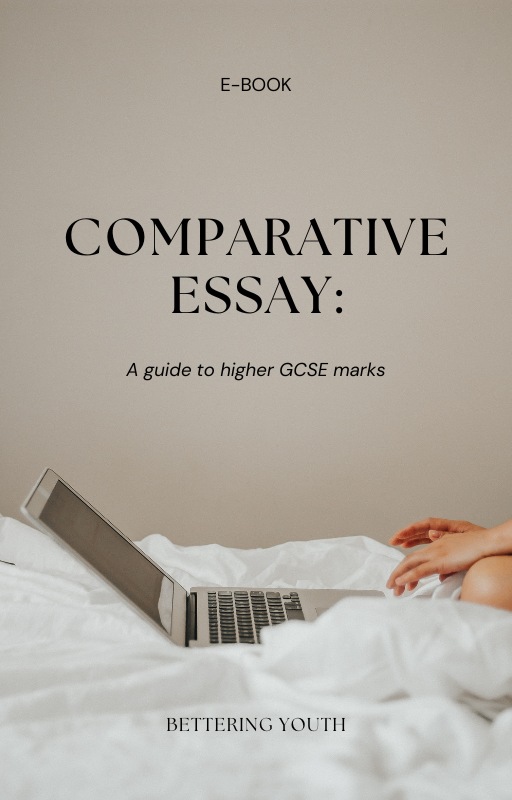In this guide, we’ll explore Command Words which is the second part of the Comparative Essay guide: Understanding Command Words
Preparation is the key to confidence.
There are three parts to this:
- First the preparation aspect of writing a comparative essay
- Second the deconstructing of the essay questions and pulling together adequate information
- Third the structure and format of a comparative essay
Continue reading to learn the second part, deconstructing essay questions.
1. Understanding Command Words used in Essay Questions
Command words are written in exam questions to tell students how to answer questions.
The following list has been taken from OFQUAL and includes the AQA additional words:
Analyse
Separate information into components and identify their characteristics.
Argue
Present a reasoned case.
Assess
Make an informed judgement.
Comment
Present an informed opinion.
Compare
Identify similarities and/or differences.
Contrast
Identify differences.
Criticise
Assess worth against explicit expectations.
Debate
Present different perspectives on an issue.
Describe
Give an account of.
Discuss
Present key points.
Evaluate
State how you react when reading the text as in ‘Evaluate the effects the descriptions have on you’.
Examine
Investigate closely.
Explain
Give reasons.
Find
Select the options that are true (or false).
2. Understanding ‘use of language’ words in Essay Questions
Describe how writers use language to achieve effects/impact (words/phrases/ language features/ language techniques/ sentence forms).
Illustrate
Present clarifying examples.
Review
Survey information.
Suggest
Present a possible case/solution.
Summarise
Present principal points without detail.
Support
Use quotations/ textual references to evidence your response.
What do you understand
Retrieve and interpret information from a text/s.
(AQA)
3. Understand Context Words in Essay Questions
Understanding Context in English Literature: A Guide for GCSE and A-Level Students
Navigating through the world of English Literature exams can be challenging, especially when faced with the enigmatic term “context.” Fear not! This guide is your trusty companion to unravel the mysteries of context for GCSE and A-Level English Literature.
What is Context?
Context, in essence, is the background, environment, and setting that influences how a text is written and read. It’s the intricate web of cultural, historical, social, and political elements that shape and mold the author’s words.
Why is Context Important?
Context is not just trivia; it’s the key to unlocking the deeper layers of meaning within a text. Whether it’s cultural, historical, or ideological, context provides the precise information needed to comprehend and appreciate literature fully.
In your English Literature exams, understanding context becomes crucial. It’s not just a box to tick; it’s a tool that enables you to unravel texts, grasp character nuances, decipher themes, and understand authorial intentions.
Author’s Context vs. Reader’s Context
Consider the stark difference between Jane Austen penning her novels in the Georgian era and you, curled up in bed with modern music playing. The context in which a text is written and read shapes interpretations.
Explore aspects such as:
- When the text was written
- Author’s age during writing
- Society and influences at the time
- Political and social climate
- Intended audience
Types of Context to Explore:
- Biographical Context:
- Events or places from the author’s life reflected in the text
- People or relationships influencing the text
- Author’s ideas or beliefs reflected
- Historical and Social Context:
- When the text was written
- Political or social influences
- References to historical events
- Society’s impact on the text’s meaning
- Cultural Context:
- Way of life, religion, race, and nationality
- Comments on or clash of cultures within the text
- Ideological Context:
- Systems of beliefs underpinning attitudes and behavior
- Exploration, challenge, or championing of ideologies
- Context of Readership:
- How readers engaged with the text when produced
- How different readers interpret the text over time
Using Context in Essays:
When weaving context into your essays:
- Integrate context throughout; don’t isolate it in a stand-alone paragraph.
- Relate context to different elements of your argument.
- Offer relevant information, tailored to the question.
- Maintain a balance; too much or too little context can hinder understanding.
Remember, context typically accounts for 15-25% of your marks, so find that sweet spot of moderation.
Examples of Context in Literature:
Animal Farm (by George Orwell):
Orwell’s disillusionment with Soviet Communism influenced Animal Farm. Understanding the Russian Revolution’s historical context unveils the allegorical characters and satire within the novel.
Concluding thoughts on understanding key words in Essay Questions
An important part of answering your essay question well is understanding what it is asking of you. Before moving on with answering the question, take some time to highlight the command words and understand the explicit ask. Plan your response and use key words that will help the evaluator know that you understand the task.
Mastering the Art of Essays
- part 1: preparing for your comparative essay
- part 3: the format of your comparative essay
- Mastering the Art of Essay Writing: A Comprehensive Guide
Comparative Essay Worksheet

Download our Free Comprehensive Guide to Comparative Essays and boost your English GCSE Marks
